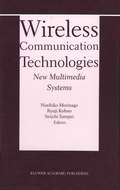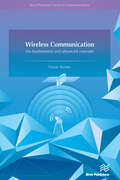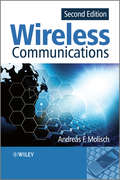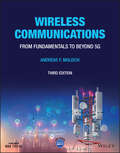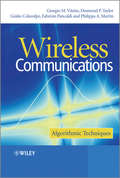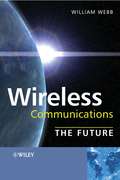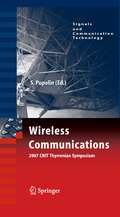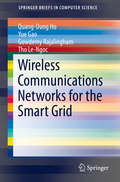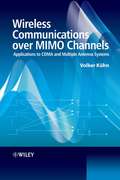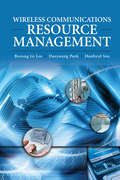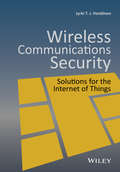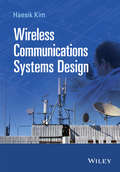- Table View
- List View
Wireless Communication Technologies: New MultiMedia Systems (The Springer International Series in Engineering and Computer Science #564)
by Norihiko Morinaga Ryuji Kohno Seiichi SampeiDuring 12-15 of September 1999, 10th International Symposium on P- sonal, Indoor and Mobile Radio Communications (PIMRC’99) was held in Osaka Japan, and it was really a successful symposium that accommodated more than 600 participants from more than 30 countries and regions. PIMRC is really well organized annual symposium for wireless multimedia commu- cation systems, in which, various up-to-date topics are discussed in the invited talk, panel discussions and tutorial sessions. One of the unique features of the PIMRC is that PIMRC is continuing to publish, from Kluwer Academic Publishers since 1997, a book that collects the hottest topics discussed in PIMRC. In PIMRC’97, Invited talks were sum- rized in “Wireless Communications –TDMA versus CDMA – (ISBN 0-7923- 8005-3),” and it was published just beforePIMRC’97. This book was also distributed to all the PIMRC’97 participants as a part of proceedings for the conference. In PIMRC’98, extendedversion of the invited papers were s- marized in Wireless Multimedia Network Technologies (ISBN 0-7923-8633- 7) and published in September 1999, which is almost the same timing for the PIMRC’99. In the case of PIMRC’99, to produce more informative book, we have - lected topics that attracted many PIMRC’99 participants during the conf- ence, and invited prospective authors not only from the invited speakers but also from tutorial speakers, panel organizers, panelists, and some other exc- lent PIMRC’99 participants.
Wireless Communication-the fundamental and advanced concepts (River Publishers Series In Communications Ser.)
by Sanjay KumarWireless communication is one of the fastest growing fields in the engineering world today. Rapid growth in the domain of wireless communication systems, services and application has drastically changed the way we live, work and communicate. Wireless communication offers a broad and dynamic technological field, which has stimulated incredible excitements and technological advancements over last few decades. The expectations from wireless communication technology are increasing every day. This is placing enormous challenges to wireless system designers. Moreover, this has created an ever increasing demand for conceptually strong and well versed communication engineers who understand the wireless technology and its future possibilities. In recent years, significant progress in wireless communication system design has taken place, which will continue in future. Especially for last two decades, the research contributions in wireless communication system design have resulted in several new concepts and inventions at remarkable speed. A text book is indeed required to offer familiarity with such developments and underlying concepts, to be taught in the classroom to future engineers. This is one of the motivations for writing this book. Practically no book can be up to date in this field, due to the fast ongoing research and developments. The new developments are announced almost every day. Teaching directly from the research papers in the classroom cannot build the necessary foundation. Therefore need for a textbook is unavoidable, which is integral to learning, and is an essential source to build the concept. The prime goal of this book is to cooperate in the learning process.
Wireless Communication-the fundamental and advanced concepts
by Sanjay KumarWireless communication is one of the fastest growing fields in the engineering world today. Rapid growth in the domain of wireless communication systems, services and application has drastically changed the way we live, work and communicate. Wireless communication offers a broad and dynamic technological field, which has stimulated incredible excitements and technological advancements over last few decades. The expectations from wireless communication technology are increasing every day. This is placing enormous challenges to wireless system designers. Moreover, this has created an ever increasing demand for conceptually strong and well versed communication engineers who understand the wireless technology and its future possibilities. In recent years, significant progress in wireless communication system design has taken place, which will continue in future. Especially for last two decades, the research contributions in wireless communication system design have resulted in several new concepts and inventions at remarkable speed. A text book is indeed required to offer familiarity with such developments and underlying concepts, to be taught in the classroom to future engineers. This is one of the motivations for writing this book. Practically no book can be up to date in this field, due to the fast ongoing research and developments. The new developments are announced almost every day. Teaching directly from the research papers in the classroom cannot build the necessary foundation. Therefore need for a textbook is unavoidable, which is integral to learning, and is an essential source to build the concept. The prime goal of this book is to cooperate in the learning process.
Wireless Communication with Artificial Intelligence: Emerging Trends and Applications (Wireless Communications and Networking Technologies)
by Anuj Singal Sandeep Kumar Sajjan Singh Ashish Kr. LuhachThis reference text discusses advances in wireless communication, design challenges, and future research directions to design reliable wireless communication. The text discusses emerging technologies including wireless sensor networks, Internet of Things (IoT), cloud computing, mm-Wave, Massive MIMO, cognitive radios (CR), visible light communication (VLC), wireless optical communication, signal processing, and channel modeling. The text covers artificial intelligence-based applications in wireless communication, machine learning techniques and challenges in wireless sensor networks, and deep learning for channel and bandwidth estimation during optical wireless communication. The text will be useful for senior undergraduate, graduate students, and professionals in the fields of electrical engineering, and electronics and communication engineering.
Wireless Communication with Artificial Intelligence: Emerging Trends and Applications (Wireless Communications and Networking Technologies)
by Anuj Singal Sandeep Kumar Sajjan Singh Ashish Kr. LuhachThis reference text discusses advances in wireless communication, design challenges, and future research directions to design reliable wireless communication. The text discusses emerging technologies including wireless sensor networks, Internet of Things (IoT), cloud computing, mm-Wave, Massive MIMO, cognitive radios (CR), visible light communication (VLC), wireless optical communication, signal processing, and channel modeling. The text covers artificial intelligence-based applications in wireless communication, machine learning techniques and challenges in wireless sensor networks, and deep learning for channel and bandwidth estimation during optical wireless communication. The text will be useful for senior undergraduate, graduate students, and professionals in the fields of electrical engineering, and electronics and communication engineering.
Wireless Communications: Future Directions (The Springer International Series in Engineering and Computer Science #217)
by Jack M. Holtzman David J. GoodmanThe past several years have been exciting for wireless communications. The public appetite for new services and equipment continues to grow. The Second Generation systems that have absorbed our attention during recent years will soon be commercial realities. In addition to these standard systems, we see an explosion of technical alternatives for meeting the demand for wireless communications. The debates about competing solutions to the same problem are a sign of the scientific and technical immaturity of our field. Here we have an application in search of technology rather than the reverse. This is a rare event in the information business. Happily, there is a growing awareness that we can act now to prevent the technology shortage from becoming more acute at the end of this decade. By then, market size and user expectations will surpass the capabilities of today's emerging systems. Third Generation Wireless Information Networks will place even greater burdens on technology than their ancestors. To discuss these issues, Rutgers University WINLAB plays host to a series of Workshops on Third Generation Wireless Information Networks. The first one, in 1989, had the flavor of a gathering of committed enthusiasts of an interesting niche of telephony. Presentations and discussions centered on the problems of existing cellular systems and technical alternatives to alleviating them. Although the more distant future was the announced theme of the Workshop, it drew only a fraction of our attention.
Wireless Communications (Wiley - IEEE #34)
by Andreas F. Molisch"Professor Andreas F. Molisch, renowned researcher and educator, has put together the comprehensive book, Wireless Communications. The second edition, which includes a wealth of new material on important topics, ensures the role of the text as the key resource for every student, researcher, and practitioner in the field." —Professor Moe Win, MIT, USA Wireless communications has grown rapidly over the past decade from a niche market into one of the most important, fast moving industries. Fully updated to incorporate the latest research and developments, Wireless Communications, Second Edition provides an authoritative overview of the principles and applications of mobile communication technology. The author provides an in-depth analysis of current treatment of the area, addressing both the traditional elements, such as Rayleigh fading, BER in flat fading channels, and equalisation, and more recently emerging topics such as multi-user detection in CDMA systems, MIMO systems, and cognitive radio. The dominant wireless standards; including cellular, cordless and wireless LANs; are discussed. Topics featured include: wireless propagation channels, transceivers and signal processing, multiple access and advanced transceiver schemes, and standardised wireless systems. Combines mathematical descriptions with intuitive explanations of the physical facts, enabling readers to acquire a deep understanding of the subject. Includes new chapters on cognitive radio, cooperative communications and relaying, video coding, 3GPP Long Term Evolution, and WiMax; plus significant new sections on multi-user MIMO, 802.11n, and information theory. Companion website featuring: supplementary material on 'DECT', solutions manual and presentation slides for instructors, appendices, list of abbreviations and other useful resources.
Wireless Communications (Wiley - IEEE #15)
by Andreas F. Molisch"Professor Andreas F. Molisch, renowned researcher and educator, has put together the comprehensive book, Wireless Communications. The second edition, which includes a wealth of new material on important topics, ensures the role of the text as the key resource for every student, researcher, and practitioner in the field." —Professor Moe Win, MIT, USA Wireless communications has grown rapidly over the past decade from a niche market into one of the most important, fast moving industries. Fully updated to incorporate the latest research and developments, Wireless Communications, Second Edition provides an authoritative overview of the principles and applications of mobile communication technology. The author provides an in-depth analysis of current treatment of the area, addressing both the traditional elements, such as Rayleigh fading, BER in flat fading channels, and equalisation, and more recently emerging topics such as multi-user detection in CDMA systems, MIMO systems, and cognitive radio. The dominant wireless standards; including cellular, cordless and wireless LANs; are discussed. Topics featured include: wireless propagation channels, transceivers and signal processing, multiple access and advanced transceiver schemes, and standardised wireless systems. Combines mathematical descriptions with intuitive explanations of the physical facts, enabling readers to acquire a deep understanding of the subject. Includes new chapters on cognitive radio, cooperative communications and relaying, video coding, 3GPP Long Term Evolution, and WiMax; plus significant new sections on multi-user MIMO, 802.11n, and information theory. Companion website featuring: supplementary material on 'DECT', solutions manual and presentation slides for instructors, appendices, list of abbreviations and other useful resources.
Wireless Communications: From Fundamentals to Beyond 5G (IEEE Press)
by Andreas F. MolischAn in-depth and comprehensive treatment of wireless communication technology ranging from the fundamentals to the newest research results The expanded and completely revised Third Edition of Wireless Communications delivers an essential text in wireless communication technology that combines mathematical descriptions with intuitive explanations of the physical facts that enable readers to acquire a deep understanding of the subject. This latest edition includes brand-new sections on cutting edge research topics such as massive MIMO, polar codes, heterogeneous networks, non-orthogonal multiple access, as well as 5G cellular standards, WiFi 6, and Bluetooth Low Energy. Together with the re-designed descriptions of fundamentals such as fading, OFDM, and multiple access, it provides a thorough treatment of all the technologies that underlie fifth-generation and beyond systems. A complimentary companion website provides readers with a wealth of old and new material, including instructor resources available upon request. Readers will also find: A thorough introduction to the applications and requirements of modern wireless services, including video streaming, virtual reality, and Internet of Things. Comprehensive explorations of wireless propagation mechanisms and channel models, ranging from Rayleigh fading to advanced models for MIMO communications. Detailed discussions of single-user communications fundamentals, including modern coding techniques, multi-carrier communications, and single-user MIMO. Extensive description of multi-user communications, including packet radio systems, CDMA, scheduling, admission control, cellular and ad-hoc network design, and multi-user MIMO. In-depth examinations of advanced topics in wireless communication, like speech and video coding, cognitive radio, NOMA, network coding, and wireless localization. A comprehensive description of the key wireless standards, including LTE, 5G, WiFi, Bluetooth, and an outlook to Beyond 5G systems. Perfect for advanced undergraduate and graduate students with a basic knowledge of standard communications, Wireless Communications will also earn a place in the libraries of researchers and system designers seeking a one-stop resource on wireless communication technology.
Wireless Communications: From Fundamentals to Beyond 5G (IEEE Press)
by Andreas F. MolischAn in-depth and comprehensive treatment of wireless communication technology ranging from the fundamentals to the newest research results The expanded and completely revised Third Edition of Wireless Communications delivers an essential text in wireless communication technology that combines mathematical descriptions with intuitive explanations of the physical facts that enable readers to acquire a deep understanding of the subject. This latest edition includes brand-new sections on cutting edge research topics such as massive MIMO, polar codes, heterogeneous networks, non-orthogonal multiple access, as well as 5G cellular standards, WiFi 6, and Bluetooth Low Energy. Together with the re-designed descriptions of fundamentals such as fading, OFDM, and multiple access, it provides a thorough treatment of all the technologies that underlie fifth-generation and beyond systems. A complimentary companion website provides readers with a wealth of old and new material, including instructor resources available upon request. Readers will also find: A thorough introduction to the applications and requirements of modern wireless services, including video streaming, virtual reality, and Internet of Things. Comprehensive explorations of wireless propagation mechanisms and channel models, ranging from Rayleigh fading to advanced models for MIMO communications. Detailed discussions of single-user communications fundamentals, including modern coding techniques, multi-carrier communications, and single-user MIMO. Extensive description of multi-user communications, including packet radio systems, CDMA, scheduling, admission control, cellular and ad-hoc network design, and multi-user MIMO. In-depth examinations of advanced topics in wireless communication, like speech and video coding, cognitive radio, NOMA, network coding, and wireless localization. A comprehensive description of the key wireless standards, including LTE, 5G, WiFi, Bluetooth, and an outlook to Beyond 5G systems. Perfect for advanced undergraduate and graduate students with a basic knowledge of standard communications, Wireless Communications will also earn a place in the libraries of researchers and system designers seeking a one-stop resource on wireless communication technology.
Wireless Communications: Algorithmic Techniques
by Giorgio A. Vitetta Desmond P. Taylor Giulio Colavolpe Fabrizio Pancaldi Philippa A. MartinThis book introduces the theoretical elements at the basis of various classes of algorithms commonly employed in the physical layer (and, in part, in MAC layer) of wireless communications systems. It focuses on single user systems, so ignoring multiple access techniques. Moreover, emphasis is put on single-input single-output (SISO) systems, although some relevant topics about multiple-input multiple-output (MIMO) systems are also illustrated. Comprehensive wireless specific guide to algorithmic techniques Provides a detailed analysis of channel equalization and channel coding for wireless applications Unique conceptual approach focusing in single user systems Covers algebraic decoding, modulation techniques, channel coding and channel equalisation
Wireless Communications: Algorithmic Techniques
by Giorgio A. Vitetta Desmond P. Taylor Giulio Colavolpe Fabrizio Pancaldi Philippa A. MartinThis book introduces the theoretical elements at the basis of various classes of algorithms commonly employed in the physical layer (and, in part, in MAC layer) of wireless communications systems. It focuses on single user systems, so ignoring multiple access techniques. Moreover, emphasis is put on single-input single-output (SISO) systems, although some relevant topics about multiple-input multiple-output (MIMO) systems are also illustrated. Comprehensive wireless specific guide to algorithmic techniques Provides a detailed analysis of channel equalization and channel coding for wireless applications Unique conceptual approach focusing in single user systems Covers algebraic decoding, modulation techniques, channel coding and channel equalisation
Wireless Communications: The Future
by William WebbThe definitive assessment of how wireless communications will evolve over the next 20 years. Predicting the future is an essential element for almost everyone involved in the wireless industry. Manufacturers predict the future when they decide on product lines to develop or research to undertake, operators when they buy licences and deploy networks, and academics when they set PhD topics. Wireless Communications: The Future provides a solid, clear and well-argued basis on which to make these predictions. Starting with a description of the current situation and a look at how previous predictions made in 2000 have fared, the book then provides the contributions of six eminent experts from across the wireless industry. Based on their input and a critical analysis of the current situation, it derives detailed forecasts for 2011 through to 2026. This leads to implications across all of the different stakeholders in the wireless industry and views on key developments. Presents clear and unambiguous predictions, not a range of scenarios from which the user has to decide Includes chapters covering existing wireless systems which provide solid tutorial material across a wide range of wireless devices Offers a range of views of the future from high profile contributors in various areas of the industry and from around the globe, including contributions from Vodafone and Motorola Provides a comprehensive guide to current technologies, offering keen analysis of key drivers, end user needs and key economic and regulatory constraints This book, compiled by a renowned author with a track record of successful prediction, is an essential read for strategists working for wireless manufacturers, wireless operators and device manufacturers, regulators and professionals in the telecoms industry, as well as those studying the topic or with a general interest in the future of wireless communications.
Wireless Communications 2007 CNIT Thyrrenian Symposium (Signals and Communication Technology)
by Silvano PupolinThe 18th Tyrrhenian Workshop on digital communications is devoted to wi- less communications. In the last decade, wireless communications research boosted launching new standards and proposing new techniques for the - cess technology. We moved from the UTRA standard capable to transmit 0. 5bit/s/Hz to WLAN which is promising 2. 7bit/s/Hz. Now wireless c- munication systems are facing a ?ourishing of new proposal moving from multiple antennas at transmitter and receiver side (MIMO systems), to new powerfulForwardErrorCorrectionCodes,toadaptiveradioresourcemana- mentalgorithms. Thenewchallenge,however,isthemovetowardsmultimedia communications and IP technology. This move implies e?orts in several new aspects. First of all an open network, as IP is, imposes the necessity of a - cure network, to guarantee the privacy of the ongoing communications, avoid the use of the networks by unauthorized customers, avoid the misuses and the charge to third parties of the cost of the connection. Also, quality of service (QoS) of the communications is becoming a must in IP networks which are carrying services which need a guaranteed QoS as telephony, real time s- vices, etc. To get this new target some form of access control to the network must be setup. Recently, new form of communication networks has appeared to collect data for several applications (sensor networks, ad hoc networks, etc. ) and they need a connection with a backbone network which could be a wireless one with a larger range than the sensor or ad hoc networks.
Wireless Communications for Power Substations: RF Characterization and Modeling (Wireless Networks)
by Basile L. Agba Fabien Sacuto Minh Au Fabrice Labeau François GagnonThis book consists of the identification, characterization, and modeling of electromagnetic interferences in substations for the deployment of wireless sensor networks. The authors present in chapter 3 the measurement setup to record sequences of impulsive noise samples in the ISM band of interest. The setup can measure substation impulsive noise, in wide band, with enough samples per time window and enough precision to allow a statistical study of the noise. During the measurement campaign, the authors recorded around 120 noise sequences in different substations and for four ranges of equipment voltage, which are 25 kV, 230 kV, 315 kV and 735 kV. A characterization process is proposed, by which physical characteristics of partial discharge can be measured in terms of first- and second-order statistics. From the measurement campaign, the authors infer the characteristics of substation impulsive noise as a function of the substation equipment voltage, and can provide representative parameters for the four voltage ranges and for several existing impulsive noise models.The authors investigate in chapters 4 and 5 the modeling of electromagnetic interferences caused by partial discharge sources. First, the authors propose a complete and coherent approach model that links physical characteristics of high-voltage installations to the induced radio-interference spectra of partial discharge sources. The goodness-of-fit of the proposed physical model has been measured based on some interesting statistical metrics. This allows one to assess the effectiveness of the authors' approach in terms of first- and second-order statistics. Chapter 6 proposes a model based on statistical approach. Indeed, substation impulsive noise is composed of correlated impulses, which would require models with memory in order to replicate a similar correlation. Among different models, we have configured a Partitioned Markov Chain (PMC) with 19 states (one state for the background noise and 18 states for the impulse); this Markov-Gaussian model is able to generate impulsive noise with correlated impulse samples. The correlation is observable on the impulse duration and the power spectrum of the impulses. Our PMC model provides characteristics that are more similar to the characteristics of substation impulsive noise in comparison with other models, in terms of time and frequency response, as well as Probability Density Functions (PDF). Although PMC represents reliably substation impulsive noise, the model remains complex in terms of parameter estimation due to a large number of Markov states, which can be an obstacle for future wireless system design. In order to simplify the model, the authors decrease the number of states to 7 by assigning one state to the background noise and 6 states to the impulse and we call this model PMC-6. PMC-6 can generate realistic impulses and can be easily implemented in a receiver in order to mitigate substation impulsive noise. Representative parameters are provided in order to replicate substation impulsive noise for different voltage ranges (25-735 kV). Chapter 7, a generalized radio-noise model for substations is proposed, in which there are many discharges sources that are randomly distributed over space and time according to the Poisson field of interferers approach. This allows for the identification of some interesting statistical properties of moments, cumulants and probability distributions. These can, in turn, be utilized in signal processing algorithms for rapid partial discharge's identification, localization, and impulsive noise mitigation techniques in wireless communications in substations.The primary audience for this book is the electrical and power engineering industry, electricity providers and companies who are interested in substation automation systems using wireless communication technologies for smart grid applications. Researchers, engineers and students studying and working in wireless communication will also want to buy this book as a reference.
Wireless Communications, Networking and Applications: Proceedings of WCNA 2014 (Lecture Notes in Electrical Engineering #348)
by Qing-An ZengThis book is based on a series of conferences on Wireless Communications, Networking and Applications that have been held on December 27-28, 2014 in Shenzhen, China. The meetings themselves were a response to technological developments in the areas of wireless communications, networking and applications and facilitate researchers, engineers and students to share the latest research results and the advanced research methods of the field. The broad variety of disciplines involved in this research and the differences in approaching the basic problems are probably typical of a developing field of interdisciplinary research. However, some main areas of research and development in the emerging areas of wireless communication technology can now be identified. The contributions to this book are mainly selected from the papers of the conference on wireless communications, networking and applications and reflect the main areas of interest: Section 1 - Emerging Topics in Wireless and Mobile Computing and Communications; Section 2 - Internet of Things and Long Term Evolution Engineering; Section 3 - Resource Allocation and Interference Management; Section 4 - Communication Architecture, Algorithms, Modeling and Evaluation; Section 5 - Security, Privacy, and Trust; and Section 6 - Routing, Position Management and Network Topologies.
Wireless Communications Networks for the Smart Grid (SpringerBriefs in Computer Science)
by Quang-Dung Ho Yue Gao Gowdemy Rajalingham Tho Le-NgocThis brief presents a comprehensive review of the network architecture and communication technologies of the smart grid communication network (SGCN). It then studies the strengths, weaknesses and applications of two promising wireless mesh routing protocols that could be used to implement the SGCN. Packet transmission reliability, latency and robustness of these two protocols are evaluated and compared by simulations in various practical SGCN scenarios. Finally, technical challenges and open research opportunities of the SGCN are addressed. Wireless Communications Networks for Smart Grid provides communication network architects and engineers with valuable proven suggestions to successfully implement the SGCN. Advanced-level students studying computer science or electrical engineering will also find the content helpful.
Wireless Communications over MIMO Channels: Applications to CDMA and Multiple Antenna Systems
by Volker KuhnWireless Communications over MIMO Channels: Applications to CDMA and Multiple Antenna Systems covers both, state-of-the-art channel coding concepts and CDMA and multiple antenna systems, rarely found in other books on the subject. Furthermore, an information theoretical analysis of CDMA and SDMA systems illuminate ultimate limits and demonstrates the high potential of these concepts. Besides spatial multiplexing, the use of multiple transmit antennas in order to increase the link reliability by diversity concepts (space-time coding) is described. Another focus is the application of error control coding in mobile radio communications Accompanying appendices include: basic derivations, tables of frequently used channel models, chain rules for entropy and information, data processing theorem, basics of linear algebra, Householder reflection and Givens rotation, and the LLL algorithm for lattice reduction.
Wireless Communications Resource Management (Wiley - IEEE)
by Byeong Gi Lee Daeyoung Park Hanbyul SeoWireless technologies continue to evolve to address the insatiable demand for faster response times, larger bandwidth, and reliable transmission. Yet as the industry moves toward the development of post 3G systems, engineers have consumed all the affordable physical layer technologies discovered to date. This has necessitated more intelligent and optimized utilization of available wireless resources. Wireless Communications Resource Managem ent, Lee, Park, and Seo cover all aspects of this critical topic, from the preliminary concepts and mathematical tools to detailed descriptions of all the resource management techniques. Readers will be able to more effectively leverage limited spectrum and maximize device battery power, as well as address channel loss, shadowing, and multipath fading phenomena. Presents the latest resource allocation techniques for new and next generation air interface technologies Arms readers with the necessary fundamentals and mathematical tools Illustrates theoretical concepts in a concrete manner Gives detailed coverage on scheduling, power management, and MIMO techniques Written by an author team working in both academia and industry Wireless Communications Resource Managementis geared for engineers in the wireless industry and graduate students specializing in wireless communications. Professionals in wireless service and device manufacturing industries will find the book to be a clear, up-to-date overview of the topic. Readers will benefit from a basic, undergraduate-level understanding of networks and communications. Course instructors can access lecture materials at the companion website:(www.wiley.com/go/bglee)
Wireless Communications Security: Solutions for the Internet of Things
by Jyrki T. PenttinenThis book describes the current and most probable future wireless security solutions. The focus is on the technical discussion of existing systems and new trends like Internet of Things (IoT). It also discusses existing and potential security threats, presents methods for protecting systems, operators and end-users, describes security systems attack types and the new dangers in the ever-evolving Internet. The book functions as a practical guide describing the evolvement of the wireless environment, and how to ensure the fluent continuum of the new functionalities, whilst minimizing the potential risks in network security.
Wireless Communications Security: Solutions for the Internet of Things
by Jyrki T. PenttinenThis book describes the current and most probable future wireless security solutions. The focus is on the technical discussion of existing systems and new trends like Internet of Things (IoT). It also discusses existing and potential security threats, presents methods for protecting systems, operators and end-users, describes security systems attack types and the new dangers in the ever-evolving Internet. The book functions as a practical guide describing the evolvement of the wireless environment, and how to ensure the fluent continuum of the new functionalities, whilst minimizing the potential risks in network security.
Wireless Communications Systems Architecture: Transceiver Design and DSP Towards 6G (Synthesis Lectures on Engineering, Science, and Technology)
by Khaled Salah MohamedThis book discusses wireless communication systems from a transceiver and digital signal processing perspective. It is intended to be an advanced and thorough overview for key wireless communication technologies. A wide variety of wireless communication technologies, communication paradigms and architectures are addressed, along with state-of-the-art wireless communication standards. The author takes a practical, systems-level approach, breaking up the technical components of a wireless communication system, such as compression, encryption, channel coding, and modulation. This book combines hardware principles with practical communication system design. It provides a comprehensive perspective on emerging 5G mobile networks, explaining its architecture and key enabling technologies, such as M-MIMO, Beamforming, mmWaves, machine learning, and network slicing. Finally, the author explores the evolution of wireless mobile networks over the next ten years towards 5G and beyond (6G), including use-cases, system requirements, challenges and opportunities.
Wireless Communications Systems Design
by Haesik KimWireless Communications Systems Design provides the basic knowledge and methodology for wireless communications design. The book mainly focuses on a broadband wireless communication system based on OFDM/OFDMA system because it is widely used in the modern wireless communication system. It is divided into three parts: wireless communication theory (part I), wireless communication block design (part II), and wireless communication block integration (part III). Written by an expert with various experience in system design (standards, research and development)
Wireless Communications Systems Design
by Haesik KimWireless Communications Systems Design provides the basic knowledge and methodology for wireless communications design. The book mainly focuses on a broadband wireless communication system based on OFDM/OFDMA system because it is widely used in the modern wireless communication system. It is divided into three parts: wireless communication theory (part I), wireless communication block design (part II), and wireless communication block integration (part III). Written by an expert with various experience in system design (standards, research and development)
Wireless Communications under Hostile Jamming: Security and Efficiency
by Tongtong Li Tianlong Song Yuan LiangThis monograph is intended for the designers and would-be designers of secure and efficient wireless communication systems under intentional interference. Along with the widespread of wireless devices, especially reconfigurable software defined radios, jamming has become a serious threat to civilian communications. In this book, going beyond traditional communication system design that mainly focuses on accurate information transmission under benign environments, we aim to enhance the physical layer security of communication systems by integrating modern cryptographic techniques into transceiver design, so as to achieve secure high-speed transmission under hostile interference with high reliability and efficiency. We revisit existing jamming patterns, and introduce new jamming patterns. We analyze the weaknesses of existing anti-jamming techniques. We present innovative and feasible anti-jamming techniques, which can strengthen the inherent security of the 3G, 4G and the upcoming 5G systems with minimal and inexpensive changes to the existing CDMA, frequency hopping and OFDM schemes. We also provide benchmarks for system performance evaluation under various jamming scenarios through capacity analysis. This book includes design principles, in-depth theoretical analysis and practical design examples, and will be of interest to academic researchers as well as professionals in industry.
